Yesterday, we looked at how to embroider a satin stitched dot, which is not as easy a task as it sounds, but once the general layout of the stitches in the top layer of satin stitch is understood, it sure makes it a lot easier to achieve a nice looking satin stitched dot.
One thing I failed to mention in that tutorial – being too caught up in the finished satin stitched top, rather than what was going on underneath – is that the padding of the dot is not actually “satin stitched.” Thanks to Carol-Anne of Threads Across the Web, who followed up the original post with a very informative comment about padding in Japanese embroidery, I decided I better complete the dot tutorial by clarifying the method of padding the dot.
And so, today, in a somewhat reversed order, I’ll show you how I do the padding for a satin stitch dot, and really for any area of satin stitch where I don’t want a layer of padding as thick as the padding on the front of the work, on the back of the work. Make sense? Let me show you!
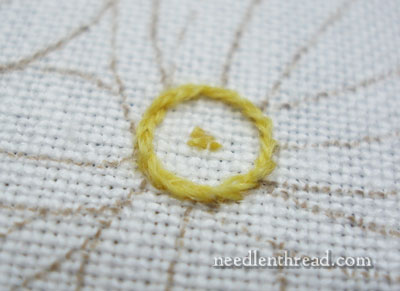
Here we are again, at the beginning of the satin stitched dot. The outline has been split stitched, and what you see inside the middle of the dot are the anchor stitches first used to secure the embroidery thread (in this case, wool).
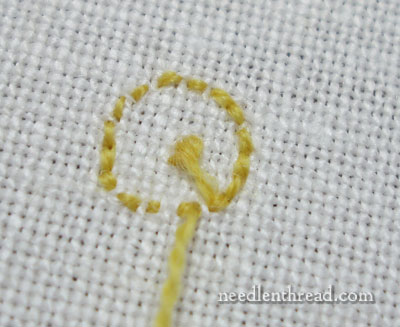
Here you see the back of the dot – where the anchor stitches are in the center, and around the circumference, you can see the back of the split stitch line, which looks pretty much like a backstitch.
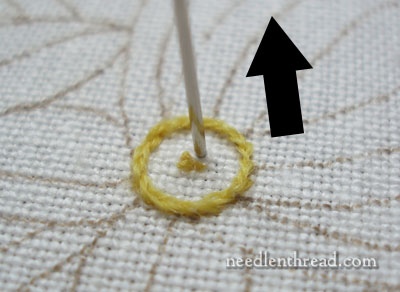
Beginning the padding, I brought my needle to the front of the fabric, just off the center of those anchor stitches, where I will begin my first layer of padding.
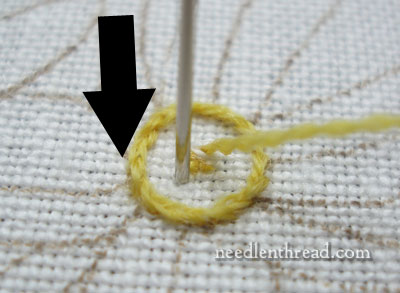
Crossing over the top of the anchor stitches, the needle goes down into the fabric, forming the first stitch of the first layer of padding, which is, for all accounts, just a simple straight stitch.
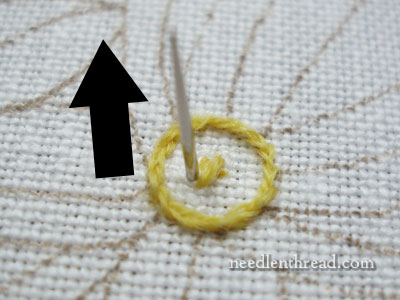
Now it’s time to come back up in the fabric. Instead of moving back to the other side where the original stitch started, I am coming up just to the other side of where I went down into the fabric at the end of the last stitch. In this way, instead of forming a complete satin stitch on the back of the fabric, there’s just a little tiny straight stitch.
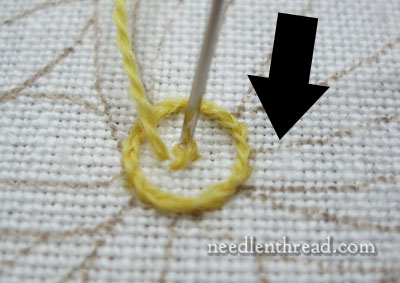
Complete the second stitch of padding by taking it down on the other side, next to where the first stitch started. For the third stitch of padding, you’ll come up next to that stitch. And as the padded area grows bigger, you’ll need to lay more stitches parallel to each other, but you’ll always start the next stitch right next to where you ended the last stitch (except when changing the direction of stitches in the the padded layer).
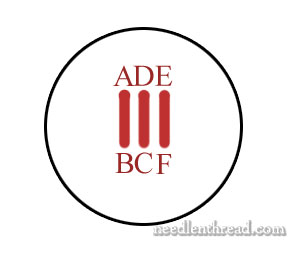
If this were to be diagrammed, it would look like this. The needle comes up at A, down at B, up at C, down at D, up at E, down at F. On the back, you would see a small straight stitch between B and C, and between D and E.
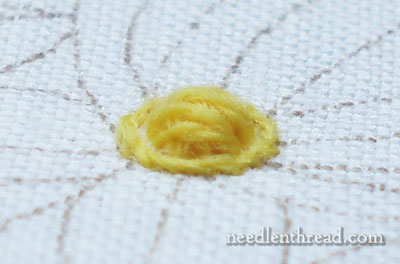
On the top of your fabric, you’re building this up. But you don’t want the same build-up underneath your fabric, so….
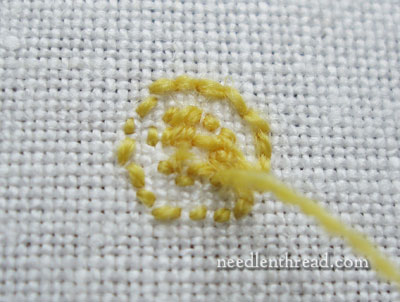
… instead of stitching across the back in satin stitch form, you move over with little tiny straight stitches. The back of the padded area will look like this, more or less, while the top will be nicely mounded up.
For the final satin stitch layer on the top of the dot – worked outside the outline as demonstrated in the satin stitch dot tutorial – you use a satin stitch that crosses across the back, too. This way, you end up with only one layer of satin stitch on the back.
Now, you might be tempted to ask – and I would be, too – why the final layer of stitches that finishes the dot isn’t stitched in the same manner as the padding stitches? Wouldn’t it, after all, save you some thread? I suppose you could stitch it in the same manner if you really wished to, but in fact, the tension on the stitch will be different, and the tiny straight stitch between the top layer of satin stitch as you move to the side will slightly skew the way the stitch lies. That tension across the back of the satin stitched area helps to hold the stitches and make them lie nicely next to each other.
Now, you might even go farther and say that, when laying stitches for laid work, you move sideways with each laid stitch just like you do with the padding stitches demonstrated above, so what’s the difference? To that, I say…. laid work is different! Over the laid work (you can see this lattice work video to see better what I’m talking about), you work other stitches to help hold the laid stitches in place. Not so with satin stitch! Satin stitch stands on its own, in all its smooth and satiny glory, without the aid of other stitches to hold it in place. When there are other stitches holding the satin stitch in place, it’s no longer satin stitch – it’s laid work.
So that’s a little reverse-order instruction on padding satin stitches! I hope you find it helpful. I’ll link to this post from the satin stitched dot tutorial, too, so that there’s a little less confusion from my convoluted approach to tutorials! (Gee, don’t you hope I don’t do this on a regular basis with my students in the classroom?!)
Thanks again, Carol-Anne! You’re a dear!







Hi Mary!
Yes, now I used to pad satin stitch this way. It turns easier to do satin stitch because the other way turns the dot too thick. I still have a long way of practice for a good looking. But I think my satin stitch looks much better now if I may say this myself 🙂
I found I have to pay much attention to two things when I do satin stitch:
first – when I go down the needle must have a little angle like / and go up the other side with an angle like \ – does it make any sense to you? is this right?
second – I also found my first satin stitches look better on the back… i found that when i come up I have to make a slight diagonal stitch and keep the parallel stitches on the front – at the beginning i was doing the opposite so satin stitch look better on the reverse side!
I still have to practice a lot and have to be very careful when doing satin stitch, sometimes I have to give up because I’m distracte with other things…
Sorry for such a long comment!
warm wishes
xxMeri
Two very good posts Mary with some hints I had never thought of and always wondered why my satin stitch left a lot to be desired. Thanks!
Hi Mary–Here’s another method, sometimes used in Brazilian embroidery.
Start the padding with a slightly bigger base layer–maybe one that goes about halfway out to the edges. Stitch this as you normally would, putting stitches on both the front and back of the fabric.
When the base layer is as big as you want it, bring the needle up through the fabric in the top middle and go down through the fabric at the bottom middle to create a stable first stitch. Bring the needle back up through the fabric next to the first stitch on one side, then put your needle underneath the stitches, BUT NOT THROUGH THE FABRIC, and slide the needle back up to the top side. Bring the needle out right next to the start of the second stitch. Don’t pull the thread too tight or you will distort the padding. When you get to the edge of the previous layer of padding, take one more stitch through the fabric to create a new edge, then go back to the middle and finish the shape off on the other side.
For the next layer, turn the fabric 90 degrees so the threads don’t slip between the previous stitches.
Clear as mud? Think of it as wrapping the previous stitches rather than going up and down through the fabric. The final top layer is stitched as a regular satin stitch, through the fabric.
This also puts minimal thread on the back, adds extra padding because with each layer you’re actually padding twice (one layer visibile, one hidden underneath the previous layers), but still takes up about the same amount of thread as going up and down through the fabric.
It also leaves a great place to bury an end.
Carol S.
In old Paragon kits (from the 1970s) this stitch was called “solid straight stitch” and it was used frequently to reduce the amount of yarn used. (Thus making the kits cheaper to produce, I imagine.) The downside is that the stitches don’t lie straight and flat. (It looks reasonably good if you’re covering an area with a ragged edge rather than a straight edge, though.)
Using it as padding for satin stitch is a great idea. I’ll have to remember that!